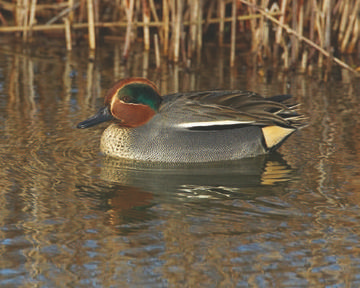
Teal © Richard Steel
Cheshire and Wirral may well be the premier county in Britain for wintering Teal, as nowhere else has three sites with conservation designations for the species. The total county population is probably around 25,000 birds, about one-sixth of the total wintering in Great Britain. The Mersey estuary has been, since the mid-1970s, the most important British site for wintering Teal, although overtaken lately by the Somerset Levels. The Mersey’s five-year peak mean is almost 10,000 birds, double the threshold for international importance and a significant part of the estuary’s status as a European Special Protection Area and Ramsar site. Nationally important totals are also found on the Dee estuary, averaging 4,400 Teal, of which about 3,000 are usually in Cheshire and Wirral, and at the Woolston Eyes, with around 2,000 birds.
Counts exceeding 1,000 Teal were also made at Rostherne (SJ78M), and flocks of more than 500 birds were recorded at Aldford (SJ45J), the upper Mersey at Astmoor (SJ58H) and Fiddler’s Ferry (SJ58M), and Elton Flash (SJ75J). Teal are not just concentrated at those major sites, however, and this Atlas shows that in winter, this is our second most-widespread duck, being recorded in half of the county’s tetrads. Despite the emphasis on large numbers at specially protected sites, more than 500 counts were submitted during the three years of this Atlas and half of them were of flocks smaller than 25 birds.
Their widespread distribution arises largely from their ability to use small patches of water, and they are often found on marl pits and farm ponds. The habitat codes submitted by observers showed birds spread across all types of waters, although they clearly avoid canals, which presumably provide little food in winter. 78 records were G1 (pond less than 50m2), 77 G2 (small water-body 50-450m2 in area), and 76 G3 (lake/ unlined reservoir). The map shows that they are not found on the upland reservoirs. 53 were on flowing water: 25 on rivers, and 28 on narrow streams or ditches. Fourteen records came from waterlogged woodland, far more than any other waterbird. Records came from 35 estuarine tetrads.
Teal feed by day and night in shallow water, by dabbling or upending, taking mainly plant seeds and some animal matter such as chironomid larvae and small snails. The mudflats, creeks and saltmarshes of the estuaries provide this combination in profusion, with the Mersey, especially along the south shore where the Teal mostly congregate, in addition offering welcome protection from the prevailing winds and a slightly warmer microclimate from the local industry. On both estuaries, the seeds of saltmarsh plants are taken, especially glasswort Salicornia and orache Atriplex; at Woolston the highest numbers of Teal have come when the operations of the Manchester Ship Canal Company have flooded no.2 bed, flushing especially seeds of fat-hen Chenopodium album and redshank Polygonum persicaria into the water. On occasion thousands of birds have been seen flying into the site at dusk to gorge on the abundant food.
The status of Teal in the county has clearly changed in the last hundred years. Coward (1910) wrote that on the estuaries it was more abundant as a bird of passage than a winter resident. Bell (1962) noted that this species had become much commoner, particularly in winter, since the beginning of the 20th century. At that time, Rostherne was the inland water with by far the largest counts, exceeding 3,000 at the peak, with similar numbers on the Mersey, even then recognised as their preferred estuarine site.
Thanks to the work of Merseyside Ringing Group, mainly Rob Cockbain at Hale Duck Decoy, we have a very good picture of the origins of our wintering Teal, which arrive here in autumn, from late August onwards, from breeding grounds to the north-east, especially in Finland and northern Russia as far east as the Pechora river. This small duck can be especially susceptible to hard weather, when shallow pools freeze. On 13 December 1981, one of the coldest days of the late 20th century, the Mersey WeBS counters were treated to the ornithological spectacle of a lifetime when a minimum of 35,000 Teal were gathered in Stanlow Bay: all inland waters were frozen and birds had flown to the estuary to find food. If driven by frost, some Teal move to Ireland, with smaller numbers to France; this is the opposite of the picture for southern England, where almost all hard-weather movements are across the Channel. Similarly, few of the birds ringed in Cheshire have wintered farther south in later years, again contrary to the national figures, and there is clearly a north-south divide in the habits of this species.
The numbers of Teal at a site can vary greatly from month to month. The British total peaks in December and January, showing that some movement continues during the winter. An extreme example of mobility was provided by one unlucky Teal ringed at Hale on 4 September 1979 at 13.00 hours that was shot the same evening on the Humber, having flown across the country during the afternoon.
Sponsored by Chester and District Ornithological Society

